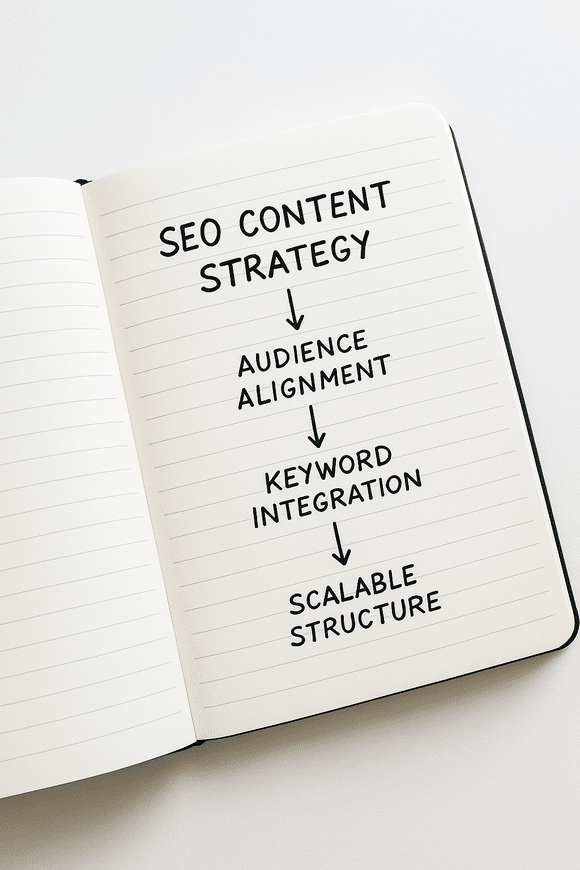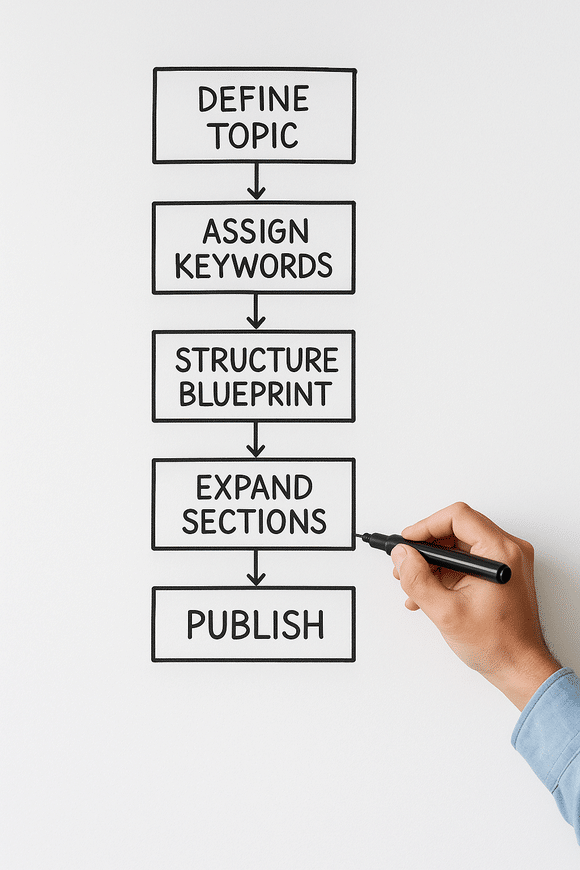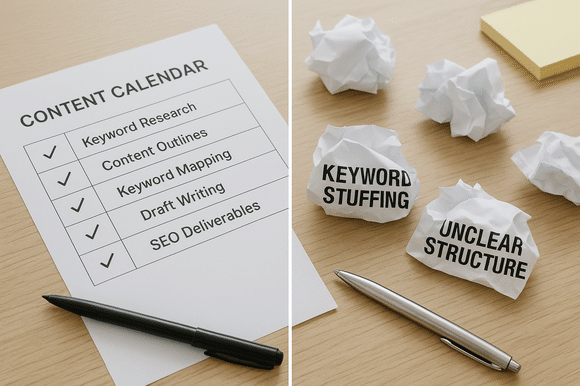SEOBoostAI – Article Prompt
Your Blueprint for Scalable, SEO-Optimized Article Creation

SEO content creation often feels complex — especially when trying to align keyword strategy, audience targeting, and technical SEO requirements in a single article. The SEOBoostAI Article Prompt was developed to simplify this challenge. It serves as a repeatable, proven framework that guides every step of the content creation process, from initial concept to fully optimized publication.
Acting as the engine of a scalable SEO content strategy, the Article Prompt combines precision structure, keyword optimization, and reader-focused formatting. Whether you're producing a one-off blog post or managing a large-scale content operation, it helps you create articles that are strategically aligned with search intent and optimized to rank in competitive search environments.
Each article built with SEOBoostAI begins with a clearly defined core topic and flows through a logical structure designed for maximum readability and SEO performance. The prompt encourages the natural integration of primary and secondary keywords such as "SEO content creation" and "optimize articles for search engines", ensuring that your content maintains keyword integrity without sacrificing user experience.
Unlike fragmented writing methods that rely on guesswork, the SEOBoostAI Article Prompt brings clarity and repeatability to your process. It leverages a systematized, blueprint-driven approach that transforms raw ideas into traffic-driving articles — complete with optimized headings, internal linking opportunities, and built-in support for metadata and Schema generation (added after article creation).
Whether you're just learning how to write SEO articles or scaling up a full content pipeline, the Article Prompt is your strategic launchpad. With it, SEO content creation becomes faster, smarter, and far more effective — helping you consistently deliver high-performing, search-optimized content at scale.
Core Topic Explanation

At the center of the SEOBoostAI system is the Article Prompt — a carefully structured framework that transforms SEO content creation into a streamlined, results-oriented process. Rather than leaving writers to navigate vague guidelines or disconnected SEO advice, the prompt acts as both a strategic map and an execution checklist that ensures every article aligns with search intent, audience expectations, and SEO best practices.
The core function of the Article Prompt is to embed SEO optimization directly into the writing workflow. Each article is built using a clearly defined structure that begins with a compelling introduction and flows through logically ordered sections — including Core Topic Explanation, SEO Relevance, Step-by-Step Strategy, and Advanced Techniques. This structure guarantees consistency, improves content quality, and enables writers to produce content that is not only informative but also designed to rank.
What makes the prompt truly powerful is its scalability. Whether you’re writing a single blog post or managing a team responsible for a full-scale SEO content strategy, the prompt adapts to any subject, audience level, or campaign goal. From a beginner’s guide to SEO article writing to highly technical long-form content, the Article Prompt offers a predictable framework that ensures consistency across your entire content pipeline.
By integrating primary and secondary keywords — such as "SEO content creation" and "optimize articles for search engines" — at optimal points within each section, the prompt maintains a balance between search engine visibility and human readability. This avoids keyword stuffing while still sending strong SEO signals.
Ultimately, the Article Prompt frees writers to focus on what matters: delivering real value to the audience. With a trusted structure in place, they can confidently create well-optimized, high-impact content that improves rankings, engages readers, and builds long-term SEO momentum — one article at a time.
Why It Matters for SEO

In an era where digital visibility determines business growth, SEO content creation is no longer optional — it’s foundational. Simply publishing content without strategy or structure rarely leads to results. The SEOBoostAI Article Prompt solves this challenge by providing a reliable, scalable system for creating content that ranks, converts, and supports long-term organic growth.
One of the most common issues faced by content teams is inconsistency. Without a strategic blueprint, articles often vary in tone, formatting, and keyword focus. This lack of cohesion makes it difficult to build authority or improve search engine rankings. The Article Prompt eliminates this problem by embedding structure, SEO logic, and keyword integration into the content from the start — ensuring every article meets performance standards.
From a technical standpoint, the prompt promotes the use of a clear heading hierarchy, strategic keyword placement, and clean formatting, which makes content easier for search engines to crawl and index. Each article naturally incorporates primary and secondary keywords like "optimize articles for search engines" and "scalable SEO content strategy" without overuse, maintaining a reader-first tone while still signaling topic relevance to search engines.
Equally important is user engagement. SEO is no longer just about keywords — it’s about aligning content with the reader’s needs. The Article Prompt helps ensure that every section is crafted to match user expectations, offering value, clarity, and actionable insights throughout the journey. This combination of technical SEO and audience alignment increases dwell time, reduces bounce rates, and improves ranking potential.
For growing teams and agencies, the scalability of the Article Prompt is a game-changer. Instead of relying on individual talent or guesswork, writers follow a consistent method that delivers repeatable results across hundreds of articles. Whether you’re creating educational content, launching a content marketing campaign, or building a full SEO content library, this system makes it easier to maintain quality and performance at scale.
In short, the SEOBoostAI Article Prompt transforms disconnected content creation into a strategic, optimized workflow. It bridges the gap between user intent and SEO performance — helping you build authority, drive traffic, and grow your digital presence with confidence.
Step-by-Step Process or Strategy

Successful SEO content creation depends on a repeatable, structured approach — one that integrates strategy, keyword planning, and SEO optimization into every stage of development. The SEOBoostAI Article Prompt provides exactly that: a clear, step-by-step blueprint designed to take your content from idea to fully optimized publication with precision and consistency.
Step 1: Define the Core Topic and Search Intent
Every high-performing article begins with a clearly defined core topic. But just identifying the subject isn’t enough — the content must also align with what users are searching for. The Article Prompt starts by encouraging writers to clarify the intent behind the query. Whether the content is a beginner’s guide to SEO article writing or a deep dive into scalable SEO content strategy, ensuring the content matches searcher expectations is key to relevance and engagement.
Step 2: Assign Strategic Keywords
Once intent is clear, the next step is selecting primary and secondary keywords that align with your topic and audience. Keywords like "SEO content creation" and "optimize articles for search engines" are embedded naturally across the article to improve discoverability. The prompt encourages strategic placement — not stuffing — ensuring keywords enhance rather than disrupt the flow.
Step 3: Structure the Article Blueprint
The Article Prompt includes a predefined structure built around a logical heading hierarchy. Standard sections like Introduction, Core Topic Explanation, SEO Importance, Strategy Steps, Best Practices, and Advanced Techniques act as content pillars. This structured flow ensures comprehensive topic coverage while improving crawlability and scannability.
Step 4: Expand Each Section with Purpose
Each section is then expanded using focused, reader-first language. The goal is to deliver value with every paragraph — providing useful insights, clear takeaways, and actionable information. The prompt encourages tight, purposeful writing that maintains reader attention while maximizing SEO potential.
Step 5: Optimize for SEO and User Experience
As content is developed, SEO is layered in through natural keyword usage, heading optimization, and internal link suggestions. Visual clarity, short paragraphs, and mobile readability are prioritized to ensure a smooth user experience. CTA placement is handled strategically, enhancing engagement without interrupting flow.
Step 6: Finalize with SEO Deliverables
After content is approved, the final step involves generating essential SEO assets — including the meta title, meta description, URL slug, keyword list, and full Schema markup (handled after article completion). These deliverables ensure the article is fully optimized for indexing, rich results, and long-term visibility.
By following this guided process, writers can produce high-quality, keyword-optimized content that meets both user needs and search engine criteria — while scaling their output with consistency and confidence.
Best Practices & Common Mistakes

To get the most out of your SEO content creation efforts, it’s essential to follow proven best practices — and just as important to avoid the common mistakes that can sabotage even the most well-intentioned articles. The SEOBoostAI Article Prompt was built to help creators succeed by reinforcing the habits that lead to higher rankings, better engagement, and long-term content success.
Best Practices:
1. Prioritize Search Intent Alignment
Start by clearly understanding what the reader is searching for and why. Align each article’s core topic with specific user intent, whether you're crafting a beginner’s guide to SEO article writing or offering advanced strategies on how to optimize articles for search engines. This ensures relevance, which is critical for both engagement and rankings.
2. Integrate Keywords Naturally
Use primary and secondary keywords like "SEO content creation" and "scalable SEO content strategy" organically throughout the article. Avoid keyword stuffing — instead, allow keywords to flow naturally within headings, body text, and CTAs. Strategic placement boosts SEO while maintaining a positive reader experience.
3. Maintain Clear Heading Structures
Organize each article using a logical heading hierarchy (H1, H2, H3) that guides the reader through the content. Clear headings not only improve readability but also help search engines index your content accurately — a crucial element of technical SEO.
4. Deliver Clear, Actionable Value
Each section should offer tangible insights or guidance. Avoid fluff. Instead, provide real examples, how-tos, and concise advice that reinforces the article’s main goal. This helps readers stay engaged and builds topical authority for your brand.
5. Think About SEO Deliverables Early
Don’t wait until the end to consider the meta title, meta description, and URL slug. As you write, think about how each section contributes to these SEO elements. This ensures better cohesion and improves your chances of appearing in relevant search results.
6. Build with Scalability in Mind
One article is a start — but a consistent, well-structured content pipeline is what drives lasting results. Use the prompt to maintain format, tone, and optimization standards across all articles, supporting a long-term scalable SEO content strategy.
Common Mistakes to Avoid:
1. Writing Without a Clear Blueprint
Jumping into content without structure often results in disorganized articles that don’t rank. The Article Prompt solves this by providing a roadmap that ensures logical flow, keyword alignment, and consistent optimization.
2. Overusing Keywords
Stuffing articles with keywords weakens readability and can hurt search visibility. SEOBoostAI encourages natural integration, helping you strike the right balance between optimization and clarity.
3. Ignoring User Experience
Even the best-optimized content can fail if it's hard to read. Use short paragraphs, simple language, mobile-friendly formatting, and intuitive structure to enhance user engagement and reduce bounce rates.
4. Skipping Internal Linking
Failing to include internal links is a missed SEO opportunity. Link relevant articles or pages to create a stronger site architecture and keep readers on your site longer. This also improves crawlability and domain authority.
5. Treating Content as One-Offs
Isolated high-quality articles won’t scale results. Think in terms of content systems, not single posts. Use the Article Prompt to ensure consistency across your growing library and build momentum over time.
6. Forgetting to Revisit Published Content
Content needs maintenance. Periodically update older articles to refresh keywords, fix broken links, and align with new search guidelines. Refreshing content can significantly extend its lifespan and SEO impact.
By internalizing these best practices — and steering clear of common pitfalls — you can use the SEOBoostAI Article Prompt to consistently produce optimized, high-performing articles that serve your audience and your rankings.
Advanced Techniques

Once you’ve mastered the fundamentals of SEO content creation using the SEOBoostAI Article Prompt, you can take your content performance to the next level by applying advanced strategies. These techniques are designed to enhance visibility, deepen topical authority, and support a scalable SEO content strategy that continues to deliver results over time.
1. Intent Layering for Expanded Reach
Rather than focusing on a single search intent, advanced users can implement intent layering — the practice of addressing multiple, related search queries within one article. For example, an article might combine queries such as "how to write SEO articles", "beginner’s guide to SEO article writing", and "optimize articles for search engines". This increases topical depth and captures a wider range of relevant traffic, boosting both impressions and engagement.
2. Secondary Keyword Theming
Instead of distributing secondary keywords randomly, group them into relevant sections to create clear keyword themes. For instance, terms related to "SEO optimization" or "content scaling" can be clustered under strategy-focused subheads. This improves semantic relevance, enhances readability, and sends stronger topical signals to search engines.
3. Strategic Internal Linking
Plan for internal links during the writing process. Linking to related articles within your site helps improve navigation, distribute authority across your content, and support the user journey. It also strengthens your site’s overall SEO by establishing a more connected and crawlable architecture.
4. Dynamic Schema Expansion
While basic Article Schema and FAQ Schema are added after article creation, advanced users can implement additional types — such as BreadcrumbList, HowTo, Review, or even Product Schema when applicable. This added structure can unlock enhanced search result features like rich snippets, increasing visibility and click-through rates.
5. Evergreen Content Refresh Cycles
Build a system for refreshing content every 6 to 12 months. Revisit published articles to update outdated information, refresh primary and secondary keywords, fix broken links, and align with evolving SEO standards. Regular updates not only extend content lifespan but also signal to search engines that your site stays current and authoritative.
6. Modular Content Repurposing
Use the structured format of the Article Prompt to repurpose content across multiple formats — such as slide decks, social posts, newsletters, and videos. By modularizing your content pipeline, you amplify reach while staying aligned with your core SEO content strategy.
7. Performance Benchmarking
Measure how your SEO articles perform using analytics tools. Track rankings, traffic, bounce rate, and engagement metrics. Use insights from high-performing articles to replicate success across future content while identifying areas for improvement in underperforming posts.
By incorporating these advanced techniques into your SEO workflow, you move beyond basic optimization and into a more strategic, scalable model. The SEOBoostAI Article Prompt supports this progression by offering the structure and flexibility needed to evolve with your growing content ecosystem — helping you build search-dominating content that compounds in value over time.
Conclusion & CTA

Mastering SEO content creation doesn't require guesswork — it requires a system. The SEOBoostAI Article Prompt delivers exactly that: a repeatable, scalable framework that simplifies your writing process while ensuring each article is optimized for both users and search engines. Whether you're writing a single blog post or building out a full scalable SEO content strategy, this prompt empowers you to produce consistent, high-impact content with ease.
By following the structured blueprint — from topic selection and search intent alignment to natural keyword integration and structured optimization — you can create articles that rank higher, engage deeper, and convert better. With built-in support for primary and secondary keywords like "SEO content creation" and "optimize articles for search engines", you no longer have to choose between technical SEO and quality writing. The prompt brings both into perfect alignment.
More importantly, the system is designed to scale. Whether you're just starting out or managing a full editorial calendar, the prompt provides the consistency and structure needed to build a robust, evergreen content pipeline. Every article produced becomes a strategic asset — supporting organic growth, strengthening domain authority, and advancing your broader digital goals.
Now is the perfect time to streamline your workflow, increase your efficiency, and elevate your content quality across the board. The SEOBoostAI Article Prompt isn’t just a writing tool — it’s your long-term strategy for growth through content.
Don’t let inconsistency or uncertainty slow you down. Take the first step toward content that performs.
Start using the SEOBoostAI Article Prompt today and watch your SEO content strategy reach new levels of visibility, engagement, and results.
Frequently Asked Questions

What is the SEOBoostAI Article Prompt?
The SEOBoostAI Article Prompt is a structured framework that guides the SEO content creation process from start to finish. It provides a strategic blueprint that ensures every article is built around search intent, keyword relevance, and structured formatting. By following the prompt, writers can produce content that consistently ranks in search engines and meets the expectations of their target audience.
How does the Article Prompt improve SEO content creation?
Unlike ad-hoc writing approaches, the Article Prompt embeds SEO best practices directly into your workflow. It aligns your content with primary and secondary keywords like "SEO content creation" and "optimize articles for search engines", ensures proper heading hierarchy, and supports logical flow. This results in higher-quality articles that are optimized for both readability and discoverability.
Can beginners use the SEOBoostAI Article Prompt effectively?
Absolutely. The prompt was specifically designed to support creators at all skill levels — including beginners. It simplifies the writing process into manageable, clearly defined steps, making it easy to follow whether you're writing your first SEO article or refining an existing content pipeline.
What makes the Article Prompt scalable for teams or agencies?
The power of the prompt lies in its repeatability and structure. It ensures consistency in tone, optimization, and formatting across dozens or even hundreds of articles. This allows teams to produce content at scale without sacrificing quality — making it ideal for agencies, in-house marketing teams, or editorial managers building a scalable SEO content strategy.
How does the Article Prompt support long-term SEO growth?
By using a systematized approach, the prompt enables creators to build a content library that compounds in value over time. Each article is designed to support broader SEO goals, reinforce topical authority, and drive sustained organic traffic. When combined with regular content updates and internal linking, the prompt helps strengthen your site's visibility, authority, and long-term rankings.